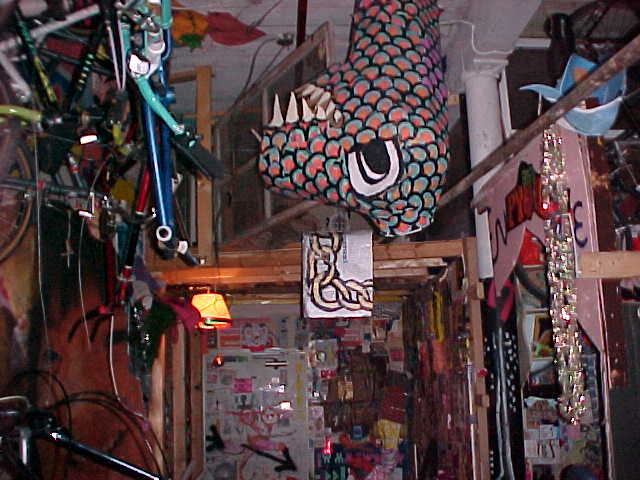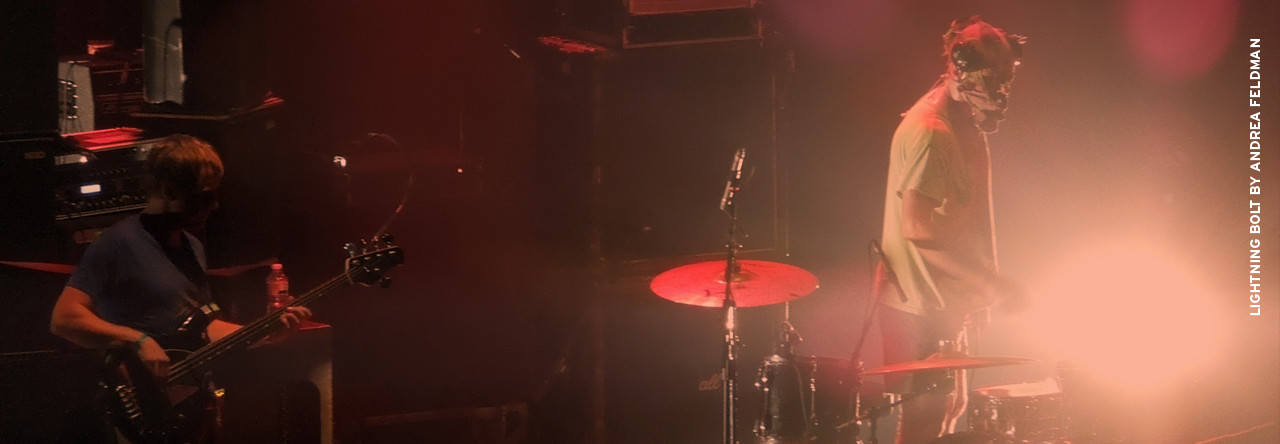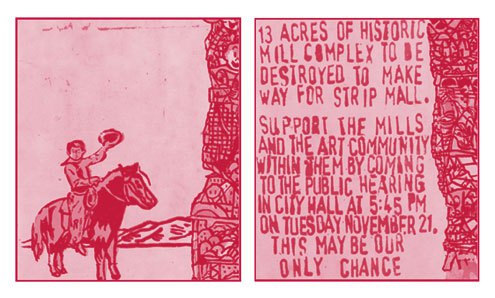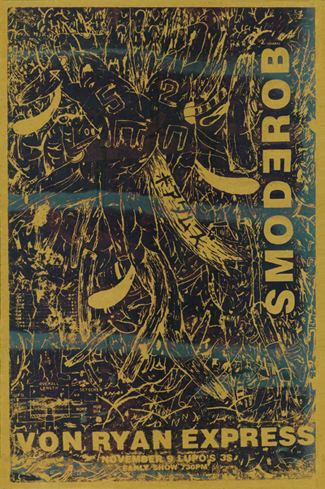The October issue of Take Magazine fixes its lens on the weird, many-headed hydra that is the Providence noise scene.
Writer Phil Eil (formerly news editor of the much-missed Providence Phoenix, where I also cut my teeth) admits straight away that the multivalent topic “could be a book,” and that the “scene is complex and unclassifiable” — but “important to acknowledge.” [The piece is print-only, but Eil has written a colorful intro here.]
With only 2,400 words to pin down a multidisciplinary, slippery beast, he makes the canny decision to present discrete moments in time — snapshots in Technicolor.
I talked to Phil for the piece, and did my best to paint a picture of how the scene “was just a balance of chaos and community,” as AS220’s Dave Dvorchak puts it.
Here’s what I sent over to Phil. Addendum: My 2006 review of Wunderground, the RISD Museum’s Fort Thunder art/music/performance retrospective, as well as some choice Olneyville sounds. Enjoy!
When I mention Providence’s noise/experimental scene, what comes to mind?
Two things: AS220 and Fort Thunder. Of course there have been other notable venues (Dirt Palace among them), but those two were especially significant for garnering national attention for our weird little town.
When I first started going to AS220, they were on Richmond St., close to much-revered dive Club Babyhead (née Rocket). Babyhead had relatively eclectic booking policies, erring on the “alt rock” side of things. AS220, by contrast, was totally freeform — on a single night you might see a doomy synth duo, a free jazz quartet and a high school piano virtuoso.
Marrying thrash-metal dynamics to the anarchic angularity of Japanoise, Lightning Bolt were certainly one of the loudest bands I’d ever heard.
But AS220 might never have become a Providence institution if Umberto Crenca hadn’t had the foresight to start fundraising to buy a permanent space. Taking cues from NY gallery peers, he realized that the downtown arts community needed an unjuried art/music/performance space, and the freedom to use it for projects that didn’t necessarily have commercial potential. Fundraising + grant-writing became as crucial to the AS220 mission as their open-minded booking policies.
Since the purchase of that first building, AS220 has become a major player on the Providence scene; they have used that power to carve out more galleries, more after-school educational programs, and more open space for projects that might otherwise fall through the cracks.

Fort Thunder. Photo via The Comics Journal.
As for Fort Thunder, I don’t think I realized its significance until I moved to San Francisco in 2001, where the SF music press whispered reverently about “the Providence noise scene.” In the late ‘90s and early 2000s, Providence had a perfect confluence of young artists (often RISD-educated) and cheap, often illegal live-work spaces. There were so many shows it was hard to keep up!
One thing I remember very strongly from Fort Thunder was being totally surrounded by art. It was an art explosion: messy and surreal, and a bit overwhelming.
You never forgot that Fort Thunder was also home to these artists — if you wanted a beer between acts, you walked over to the fridge and grabbed one.
The sounds of Fort Thunder weren’t delicate: They were sweaty, churning, ribcage-rattling noises. Aggressive and direct from the gut.
Nothing epitomizes that more succinctly than Lightning Bolt. The first time I saw them I didn’t actually see them at all — since they prefer to play at crowd-level rather than on stage, they ended up being completely swallowed up by a sea of delirious fans. Marrying thrash-metal dynamics to the anarchic angularity of Japanoise, they were certainly one of the loudest bands I’d ever heard up until that point (louder even than Band of Susans). Their brutal art-noise freakout electrified the whole room.
Show/performance that made an impression on you?
Terrastock’s 1997 and 2006 Providence invasions were crucial to Providence’s noise-evolution.
In 1997, mostly pre-internet, it was simply unprecedented to see bands like Flying Saucer Attack, Bevis Frond, and the Silver Apples in Providence. I mean, I had friends who came over from the UK just for the festival! There wasn’t a lot of tourism to Providence in those pre-Waterfire days, but Terrastock drew music makers and fans from all over the world.
Both festivals were small enough that you could actually talk to musicians you’d admired for years.
In 1997, I remember being thrilled when Damon & Naomi (Galaxie 500) set up a booth to sell books by Exact Change, their small press focused on Surrealism, pataphysics and poetry. (I think I bought them out!)
The 1997 Terrastock had a side room dedicated to a constant, rotating lineup of collaborative music, mostly improvised, by folks like Tom Rapp, Windy & Carl, and Barbara Manning. It was fun to see structured sets by the musicians, then go down the hall to see them jam with their peers.
Having two Terrastocks within a 10-year span really cemented the city’s reputation as an experimental music center.
Does Providence have more “weird” music than elsewhere?
If you take the per capita approach, probably! We pack a lotta weird into a small city footprint.
Important to convey about PVD noise scene?
I don’t know that the Providence noise scene would have developed in such a strong way without the availability of cheap, massively huge mill buildings that were tailor-made for putting on insanely loud shows. They were also in under-populated parts of town, like Olneyville — meaning that you could make a racket with a lower probability of being ratted out to the cops. (Of course, Fort Thunder ended up being bulldozed, making it yet another in the long line of artist communities that helped make a neighborhood palatable, only to be repaid with an eviction notice.)
Extra: Providence Wunderground [written in 2006]
Wunderground is an ambitious show at the RISD Museum that attempts to chronicle the city’s radical underground art scene from 1995 to the present. There will be 8 artists-in-residence (including Lightning Bolt’s own Brian Chippendale) working on a sculptural centerpiece rising up through the soaring 30-foot high main gallery. There will also be a show devoted to poster art.
The show promises to be (nearly) as colorful and raucous as the scene it documented. Before the city was overrun by yuppie development, there was plenty of space to be found in sprawling, often run-down, quasi-legal warehouses and mill buildings. It was the perfect atmosphere to fuel an intense, diverse, and collaborative local scene. Fort Thunder was the chaotic eye of the storm —a collective founded by artists Chippendale and Mat Brinkman that grew into a mini cottage industry (Lightning Bolt, Load Records, and comics tabloid Paper Rodeo all got their start there).
Sadly, Fort Thunder was demolished in 2002 to make way for a strip-mall (not without a long and vocal fight). If you go to the group’s website, you’ll see the rubble.
And yet, the spirit lives on. In the most obvious sense, because these artists are all still working and collaborating. But spiritually, too, because Fort Thunder stands as an inspiration (alongside other like-minded but less vaunted underground collectives that sprang up around the same time —the show’s poster lists what seems like hundreds of them, most sadly departed). Not just for its staunchly iconoclastic, DIY-ethic. The group’s stylistic diversity, confidence, and radical experimentation set the bar for other young artists in the city, and also serve as a touchstone and jumping-off point for anyone interested in pushing the boundaries of not just comics or music but any art-form.
All my hoarded copies of the Fort Thunder in-house publication, Paper Rodeo, have gone missing. I still have a stack of Mat Brinkman-screenprinted Boredoms posters I snuck down off Thayer St. telephone poles the day after the show — they were printed on cheap butcher paper in short runs of different colors. I think I snagged 6 of them, my favorites done in rich plum tones. It’ll be jarring to see them framed (?) on a museum wall.
I leave you with a crazed mini-Fort Thunder mixtape (so to speak). For more check out the mysterious ft.thunder RealSlowRadio. More mixtapes here.
![]() Olneyville Sound System, “Waste Away”
Olneyville Sound System, “Waste Away”



